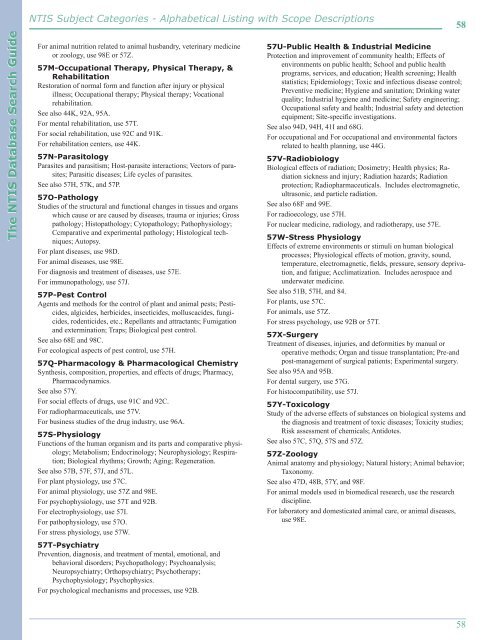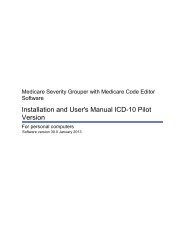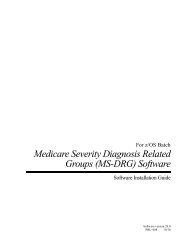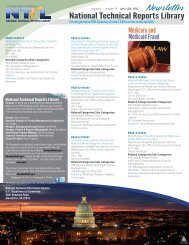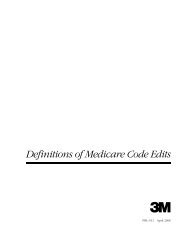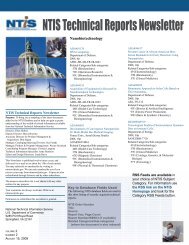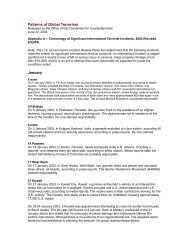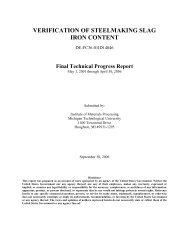DATABASE GUIDE - National Technical Information Service
DATABASE GUIDE - National Technical Information Service
DATABASE GUIDE - National Technical Information Service
You also want an ePaper? Increase the reach of your titles
YUMPU automatically turns print PDFs into web optimized ePapers that Google loves.
NTIS Subject Categories - Alphabetical Listing with Scope Descriptions58For animal nutrition related to animal husbandry, veterinary medicineor zoology, use 98E or 57Z.57M‐Occupational Therapy, Physical Therapy, &RehabilitationRestoration of normal form and function after injury or physicalillness; Occupational therapy; Physical therapy; Vocationalrehabilitation.See also 44K, 92A, 95A.For mental rehabilitation, use 57T.For social rehabilitation, use 92C and 91K.For rehabilitation centers, use 44K.57N‐ParasitologyParasites and parasitism; Host‐parasite interactions; Vectors of parasites;Parasitic diseases; Life cycles of parasites.See also 57H, 57K, and 57P.57O‐PathologyStudies of the structural and functional changes in tissues and organswhich cause or are caused by diseases, trauma or injuries; Grosspathology; Histopathology; Cytopathology; Pathophysiology;Ccmparative and experimental pathology; Histological techniques;Autopsy.For plant diseases, use 98D.For animal diseases, use 98E.For diagnosis and treatment of diseases, use 57E.For immunopathology, use 57J.57P‐Pest ControlAgents and methods for the control of plant and animal pests; Pesticides,algicides, herbicides, insecticides, molluscacides, fungicides,rodenticides, etc.; Repellants and attractants; Fumigationand extermination; Traps; Biological pest control.See also 68E and 98C.For ecological aspects of pest control, use 57H.57Q‐Pharmacology & Pharmacological ChemistrySynthesis, composition, properties, and effects of drugs; Pharmacy,Pharmacodynamics.See also 57Y.For social effects of drugs, use 91C and 92C.For radiopharmaceuticals, use 57V.For business studies of the drug industry, use 96A.57S‐PhysiologyFunctions of the human organism and its parts and comparative physiology;Metabolism; Endocrinology; Neurophysiology; Respiration;Biological rhythms; Growth; Aging; Regeneration.See also 57B, 57F, 57J, and 57L.For plant physiology, use 57C.For animal physiology, use 57Z and 98E.For psychophysiology, use 57T and 92B.For electrophysiology, use 57I.For pathophysiology, use 57O.For stress physiology, use 57W.57T‐PsychiatryPrevention, diagnosis, and treatment of mental, emotional, andbehavioral disorders; Psychopathology; Psychoanalysis;Neuropsychiatry; Orthopsychiatry; Psychotherapy;Psychophysiology; Psychophysics.For psychological mechanisms and processes, use 92B.57U‐Public Health & Industrial MedicineProtection and improvement of community health; Effects ofenvironments on public health; School and public healthprograms, services, and education; Health screening; Healthstatistics; Epidemiology; Toxic and infectious disease control;Preventive medicine; Hygiene and sanitation; Drinking waterquality; Industrial hygiene and medicine; Safety engineering;Occupational safety and health; Industrial safety and detectionequipment; Site‐specific investigations.See also 94D, 94H, 41I and 68G.For occupational and For occupational and environmental factorsrelated to health planning, use 44G.57V‐RadiobiologyBiological effects of radiation; Dosimetry; Health physics; Radiationsickness and injury; Radiation hazards; Radiationprotection; Radiopharmaceuticals. Includes electromagnetic,ultrasonic, and particle radiation.See also 68F and 99E.For radioecology, use 57H.For nuclear medicine, radiology, and radiotherapy, use 57E.57W‐Stress PhysiologyEffects of extreme environments or stimuli on human biologicalprocesses; Physiological effects of motion, gravity, sound,temperature, electromagnetic, fields, pressure, sensory deprivation,and fatigue; Acclimatization. Includes aerospace andunderwater medicine.See also 51B, 57H, and 84.For plants, use 57C.For animals, use 57Z.For stress psychology, use 92B or 57T.57X‐SurgeryTreatment of diseases, injuries, and deformities by manual oroperative methods; Organ and tissue transplantation; Pre‐andpost‐management of surgical patients; Experimental surgery.See also 95A and 95B.For dental surgery, use 57G.For histocompatibility, use 57J.57Y‐ToxicologyStudy of the adverse effects of substances on biological systems andthe diagnosis and treatment of toxic diseases; Toxicity studies;Risk assessment of chemicals; Antidotes.See also 57C, 57Q, 57S and 57Z.57Z‐ZoologyAnimal anatomy and physiology; Natural history; Animal behavior;Taxonomy.See also 47D, 48B, 57Y, and 98F.For animal models used in biomedical research, use the researchdiscipline.For laboratory and domesticated animal care, or animal diseases,use 98E.58


